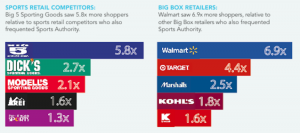
One of the most difficult (and aggravating!) aspects of Search Engine Optimization (SEO) is the constant change. Because search engine algorithms are continually enhanced to deliver better results, techniques to get your website ranking high in the results also never stop evolving.
If you ignore the shifting trends, your website could well be hit by the latest Google update and fall into the uncharted depths of search engine results beyond the first page. In short, you should never stop adapting your SEO to exploit the latest trends.
Last year, we caught you up to speed with the top SEO trends going into 2016. This year introduced an influx of rich search results, new ways to think about keywords, and a highlight on user behavior. And now, we’re back again to update your optimization game plan as 2017 fast approaches.
In this post, you’ll learn seven more important shifts in the SEO landscape, and the opportunities that lie within.

1. Keyword Rankings Are Still Important (But Come With A Twist)
Keywords are still the foundation of SEO, but how they are used continues to evolve with available technology. In 2017, be sure to pay close attention to semantic and personalized search.
Search results now adapt based on the viewer’s search history, physical location, and device type. For example, someone researching a keyword on desktop will often see different results than someone looking up the same topic on mobile. Results are also becoming more specific based on the searcher’s recent related searches, and mobile users will be handed results from websites that prioritize mobile-optimization.
Additionally, specific keywords are now less important than semantic context. Search engines interpret queries to show results based on what users mean (which isn’t always the same thing as what they searched).
While this is great news for your average Googler, the downside is that tracking the success of an SEO campaign becomes more difficult. To accurately analyze the successes and failures of your SEO strategy, you’ll now have to account for these overlapping queries.
The Opportunity:
This trend is clearly a double-edged sword, with two effects:
- A slew of new opportunities to target situational searches catered to each user’s needs.
- A blockade making it more difficult to track keyword rankings.
To avoid inaccurately tracking the impact of your SEO, take these suggestions into consideration:
- Check true rankings by using incognito mode on your browser to de-personalize results.
- Check geo-specific results by searching from each of your target locations.
- Search the same keyword on desktop and mobile to see whether results change.
This might sound like an overwhelming number of variables to keep track of, and it very well could be. Tools like Rank Tracker, which can do all of the above automatically, are handy to have around.
2. RankBrain Embraces Artificial Intelligence In SEO
It’s official: the future is now. RankBrain is a machine learning AI system incorporated into Google’s search algorithm. What’s more, it’s been officially named Google’s third-most important ranking factor.
In layman’s terms, RankBrain helps Google determine context and intended meaning for a given query. Its primary function is to sift relevant search results when a user Googles a never-before-searched or highly unusual keyword.
Due to its self-adapting nature, RankBrain’s much more difficult to abuse than most other ranking factors.
The AI places greater value on authoritative, quality content – the type of content that’s hard to fake. RankBrain’s introduction and increasing relevance coincide with an update of Google’s official search evaluator guidelines, which again places emphasis on expertise, authoritativeness, and trustworthiness. To appeal to RankBrain’s automated process, your pages need to incorporate those qualities.
The Opportunity:
The good news is that much of the SEO content writing strategies from the last few years still apply. In short: create content with a focus on authenticity, authority, and reader-friendliness, because the AI gets better at recognizing poor content every day.
If you’re new to this approach, here’s a quick breakdown on how to get started:
- Start by collecting ideas from Google AdWords Keyword Planner. The tool illustrates how keywords are grouped together by Google.
- Test out your keywords using regular Google search, checking the suggested related searches at the bottom of the page.
- Don’t intentionally stuff keywords or write to a specific density, but do incorporate a variety of similar phrases in your page in a natural way that doesn’t affect readability.
- Make sure your content can pass muster with readers. Searchers can evaluate Google’s results, and you don’t want results pages on which your website ranks highly to get negative feedback.
3. Voice Search Is Rising In Importance
The use of voice search has increased sevenfold since 2010, and it will only continue to rise as voice search continues to be directly integrated into interfaces such as Siri, Google Now, and Cortana.
Moreover, voice recognition is rapidly becoming more accurate. Compare Google’s 23% error rate in 2013 to their 8% error rate in 2015. The better voice recognition software can recognize what we say, the more people will start using it to search the web.
Voice search also allows for conversational search capabilities, making the experience a no-brainer. For example, if Google Now misinterprets a homonym you can easily correct it without starting your query from scratch.
Voice search is clearly here to stay, so it’s high time we start optimizing our websites for it.
The Opportunity:
Voice search relies on context to help with accuracy. As mentioned earlier, search engines use search history, location, and device to personalize queries and deliver more accurate results. However, tailoring your SEO approach for voice goes beyond just selecting and tracking the right keywords.
Optimization for voice search is still being explored, but some techniques are already proving more fruitful than others. Here are a few strategies to get started with:
- Prioritize long-tail keywords.
- Use schema to provide context.
- Use XML to provide microdata (e.g. with a sitemap).
- Create FAQs that answer who, what, when, where, and why.
- Research conversational queries.
4. Google AMP Deserves Your Consideration
Google Accelerated Mobile Pages, better known as Google AMP, launched in February 2016 as the new standard for mobile web content.
Research showing that slow sites correspond with lower engagement (up to 40% of visitors will leave after three seconds of load time) sparked the mobile speed optimization movement, and Google AMP was eventually born. Today, Google AMP can load pages up to 30 times faster than normal.
Google hasn’t officially declared AMP optimization a ranking factor. However, according to Condé Nast’s John Shehata, AMP pages tend to receive not only better rankings in the SERPs, but also higher click-through rates from users. And when we look to the industry, we see that 50% of SEOs expect AMP to significantly impact their rankings in mobile search results, with an additional 45% believing it will have at least some effect.
If nothing else, we do know that site speed is a ranking factor and has been for years. Thus, regardless of your standpoint, it makes sense to take advantage of AMP.
The Opportunity:
With this kind of positive impact, you’d probably think that everyone would be rushing to setup Google AMP on their websites. Yet, only 23% of SEOs report implementing it.
That means most people are still getting on board, and by being an early adopter you’ll have less competition.
If you use WordPress, it’s super-simple to add Google AMP to your site:
- Install Google AMP with the official AMP WordPress plugin.
- Ensure that the resulting code passes Google AMP validation.
- Crack open your favorite beverage to celebrate.
Installing AMP is a move with virtually no risk and potentially loads of reward.
5. The Switch To HTTPS Calls For Caution
Google began its campaign to engender more secure sites over two years ago by using HTTPs as a ranking factor.
In the past, we’ve seen websites attempt to secure their sites and experience unintended effects. So keep in mind that switching a mature site from HTTP to HTTPs all at once can cause trouble for your rankings if you don’t do it correctly.
Those who earn income from referral traffic should particularly exercise caution, as important data gets lost when an HTTPs site sends traffic to an HTTP site. If you don’t prepare accordingly, you could lose your next paycheck.
Before switching, do your homework and learn from the mistakes of those before you to properly reap the benefits of HTTPs.
The Opportunity:
If you’ve thoroughly researched HTTPs and your site is ready for the switch, use this step-by-step guide from Joe Hall to get you started.
After switching to HTTPs, you can expect to lose information interchanged only between HTTP sites but also gain information interchanged exclusively between HTTPs sites. This will obviously impact your analytics and marketing referral data, but there are a few simple workarounds:
- Use Google’s UTM tracking for specific marketing campaigns and more accurate incoming referral data.
- Maintain outgoing referral data using the meta referrer tag in the HTML of your site.
6. Citations Don’t Matter As Much For Local SEO
Long-thought one of the central pillars of local SEO, citations are mentions of your business name and address on other websites (these mentions may or may not include a link to your website).
While it’s true citations can spark higher rankings for newer websites, the strength and volume of citations have lesser of an effect these days. For businesses already established in the local search results, this takes off a bit of stress.
The Opportunity:
If you’re already ranking locally, then don’t sweat the citations. However, if you’re just starting out, here are a few tricks to land those first few:
- Research competitors’ backlinks to exploit their citation sources.
- Leverage existing relationships with local influencers and webmasters.
7. Explore SEO Beyond Google By Getting Into Bing
Believe it or not, Google isn’t the end-all and be-all of Internet searches. Bing accounts for one-third of all search engine traffic – hardly a number of users you’d want to ignore.
One cause of Bing’s apparent popularity is its status as the default search engine for several voice controlled personal assistants, including Cortana and Siri. A whopping 25% of all Bing’s search traffic is driven by voice – in fact, you may rely on Bing’s search results more often than you know.
Simply put, exploring optimization specifically for Bing results is well worth your time.
The Opportunity:
Bing optimization isn’t very different from what you’re used to with Google; if anything, it’s even more straightforward.
Begin by covering your bases. Make sure that your pages are being indexed, and increase Bing’s crawl frequency to keep your indexed content up to date.
The second step is understanding the major differences between Bing and Google optimization. For the most part, the on-page SEO techniques have little variance. However, there are a few subtle differences. For example, Bing’s keyword optimization is simpler:
- Inbound anchor text is more important.
- Keywords in domains are more important.
- Content and keyword density is important.
- Meta keywords still count, but stick to five or six at the maximum.
While Google shuns the idea of weighting a page’s rankings with social media impact, social sharing is definitely important to Bing. So by running a social media promotion after publishing content, you’ll kill two birds with one stone.
Conclusion
As the rules of SEO continue to shift towards a human-optimized world, it’s becoming harder to game the system. We think this is a great thing, but it’s still important to remember that better written, more authoritative, and more reader-friendly content is only part of the solution.
Being up-to-date with optimization aspects like AMP, HTTPs, and voice optimization is still and probably will always be a major piece of the puzzle.
Do any of these opportunities excite you, and why? Weigh in on these trends in the comments section below!
* Adapted lead image: Public Domain, pixabay.com via getstencil.com
7 Leading SEO Opportunities For 2017
The post 7 Leading SEO Opportunities For 2017 appeared first on Search Engine People Blog.
(43)



